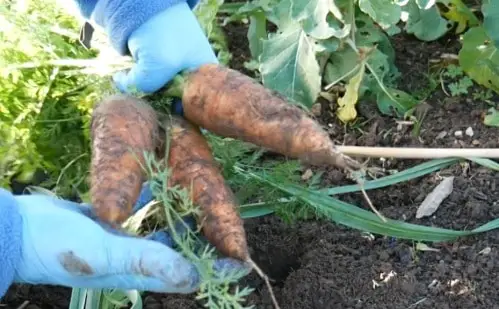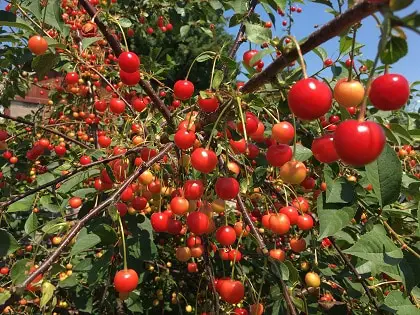Plants that Grow in Shade in the Garden
Plants that grow in shade are a bonus in the garden. The amount of shade or light in your garden will depend on the direction your garden faces, whether there are buildings, fences and tall plants surrounding your garden and the time of year. The selection of fruits and vegetables that grow in shade might influence how you lay out your garden. In the northern hemisphere
- North facing gardens will have the least light and may be damp
- East facing gardens will have light in the morning
- South facing gardens will have the most light
- West facing gardens will have light in the afternoon and evening.
In the southern hemisphere this is reversed.
Plants have adapted to grow in all of these conditions and have been found in seemingly the most inhospitable growing conditions.
5 Veg that tolerate partial shade

Carrots will tolerate afternoon shade. Sow carrot seeds thinly where they are to grow or thin carrots carefully to avoid crushing the leaves as the smell will attract carrot fly.
Leeks will grow happily with morning sun and afternoon shade. By choosing early and late maturing varieties, you can harvest leeks for almost six months a year.
Kale tolerates light shade. Whether you choose a low growing variety, like curly dwarf or a tall variety, like Cavello di Toscana, kale will grow happily in light shade and can provide fresh green vegetable option during the hungry gap. Leave the flowers to form and they can also be eaten like a sprouting broccoli.
Broad beans grow well in dappled shade. Can be sown in autumn or spring. Autumn sown varieties like Aquadulce Claudia will give an earlier crop.
Swiss chard. A hardy vegetable which will usually run to seed in the second year. The bright stems of Swiss chard can provide colour throughout the winter and unlike spinach, the leaves do not become bitter as it starts to flower. A useful crop for the hungry gap.
5 Fruits for partial shade
Plums will tolerate partial shade, plant where they can get morning sun and afternoon shade. They prefer moist, but not waterlogged soil. Plant in autumn and winter as bare root trees or container grown trees all year depending on soil conditions. This video shows how to plant fruit trees.
Blackcurrants will tolerate partial shade. They are easy to grow and to propagate from cuttings. Modern varieties offer larger currants and plants that are more upright in habit for smaller spaces. High in vitamin C, the fruits freeze well and make good jams and jellies.
Gooseberries tolerate shade, they are easy to care for and grow in most types of soil. Dessert types, eaten without cooking, will grow and produce a crop in shade, but the fruits will be sweeter when growing in sunshine. Or for a shady spot, try a culinary variety like Invicta.
Cherries. Acid cherries do not need sunshine to sweeten them and therefore are suitable for shadier sites. They are attractive plants that grow in shade, offering interest for 3 seasons of the year. In spring they are covered in blossom, followed by colourful fruits and in autumn the leaves provide colour too. The variety Morello gives heavy crops of very deep red fruit.

Pears require some sun, but will produce a crop in partial shade. Plant in a spot where they get some sunshine during the day. If space is limited, a tree that has more than one variety grafted to the rootstock will provide a longer harvesting period.
5 Ornamental and flowering plants
Apart from the fruits and vegetables that grow in shade, there is a host of ornamental and flowering plants that grow well and provide colour and texture in the garden.
Climbing Hydrangea, Hydrangea anomala subsp petiolaris, is a hardy, deciduous, woody climber with cream flowers in summer against dark green leaves. 15m x 10 m, may take a few years to start to cling to its support, but then will quickly cover a large area.

Cyclamen, Cyclamen, is a hardy tuber, this low growing plant holds its pink, red or white flowers above dark green leaves, often marbled with cream or silver. 10cm x 10cm. It spreads via seed and forms an attractive mat of foliage and flowers. Suitable for dry shade.
Magnolia, Magnolia is a hardy to frost-hardy shrub growing 3m x 3.5m (and larger). Flowers range from white to deep pink with dark green leaves. Ideal as specimen plants or among trees and shrubs.
Plantain Lily, Hosta, is a hardy perennial with white to mauve flowers in summer over green to grey leaves. A variety of leaf colours and sizes are available. Average size 30 cm x 1m, although there are some slightly taller varieties. Interestingly, many hostas are said to be edible, although we haven’t tried them!
Barrenwort, Epimedium is a hardy perennial. It usually bears flowers in spring and has bronze tinged leaves which turn green. Flower colours range from white through purple, with many pinks and yellows varieties available too. 35cm x 45cm, a clump forming ground cover plant will also thrive in dry shade.
5 Vegetables for shade

From cabbages to kale, broccoli to Brussels sprouts, brassicas offer a wide range of size, shape and tastes for the kitchen garden. These leafy green plants will tolerate and grow in some shade and should thrive if offered some protection against cabbage white butterfly and cabbage moth. You don’t need to buy expensive equipment as there are some simple ways to make a brassica tunnel.
Beetroot are shade tolerant, but start them in brighter conditions, multi-sown in modules is ideal. There are a variety of colours of beets, giving extra interest in the kitchen. You can even make wine from beetroot. See the video of how to make beetroot wine.
Salad leaves, especially non-hearting varieties, like oak-leaf or mizunas are useful. Sow little and often to provide a continuous crop.
Radishes which grow rapidly and are ready to harvest in a 3-5 weeks, depending on variety and growing conditions.
Kohlrabi, sow little and often, the leaves can be eaten like cabbage and the swollen stems can be grated into salads or roasted, added to stews etc.
5 Fruits that grow in shade
Alpine strawberries are tougher and hardier than the larger strawberries and will grow quite happily in shade. A low maintenance plant, they often hold their fruit above the leaves making them easier to harvest. The fruits are small and sweet, but you will need to grow several plants to provide enough to make a jar of jam. Relatively trouble-free, they are ideal for use as ground cover in an edible landscape or food forest.
Redcurrants and whitecurrants grow well in partial shade, but will crop well even when grown against a north facing wall, but the fruits will be sweeter if grown in sun.
Raspberries are low maintenance plants that will offer a decent crop even in shadier areas. Autumn fruit varieties, like Autumn Bliss, of raspberries are very easy to care for. Less commonly grown, but an interesting addition to the garden are varieties with yellow, white or black fruits.
Rhubarb is a useful plant, early varieties, like Timperley Early, can be harvested from early spring to mid-summer. If space permits, grow more than one variety for a longer harvesting season. Tolerant of shade, rhubarb prefers a soil that has been enriched before planting or mulch with organic matter around the crown during the winter months.

Blackberries, cultivated varieties produce larger berries, often earlier than the wild blackberry. Thornless varieties, like Oregon or Loch Ness, make the plants easier to handle when training them and picking the berries less tricky.
5 Shade loving ornamental and flowering plants
In contrast to the fruits and vegetables that grow in shade, many of the ornamental and flowering plants are at their best during the winter months and through into early spring, providing colour, fragrance and interest at a time when much of the garden is dormant.
Stinking Helebore, Helebore foetidus, a hardy perennial with green leaves and a paler green flower, 30cm x 30cm, it grows easily, including in slightly dry shade, flowering in winter. Remove the flowering stems once they have flowered.
Royal Fern, Osmunda reglais, hardy, bright green 2m x 1m, deciduous fern with bright green fronds. Rust-brown fertile fronds appear in summer. Needs moist soil.
Periwinkle, Vinca, hardy ground cover plant, 30cm x 1m. Evergreen, vigorous growing, cut back in spring to keep in check.
Mahonia, Mahonia, hardy shrub with bright yellow flowers against dark green foliage, 1m x 1.5m. An evergreen shrub with spiky leaves, it has scented flowers in winter followed by purple blue berries.
Camellia, Camellia, is a frost-hardy shrub. The flowers range from white to pink to red against dark green leaves. 5m x 4m. It flowers in spring and need an acid soil to thrive, they can be grown in pots with ericaceous compost where your soil is not acid. The International Camellia Society website is packed with information about these lovely shrubs.
So there it is, my quick guide to plants that grow in shade and in partial shade. I’ve created a full list of all the plants, including fruits and vegetables that grow in the shade, and the varieties that we grow at Byther Farm which can be found on our Resources page, What We Grow.
- Bulbs for summer and autumn - July 4, 2025
- Showstopper flowers in early summer - June 20, 2025
- Best flowering variegated plants - June 13, 2025

The front of my house is north facing so I’ve not really grown anything out there, however… during lockdown in March I realised that quite a lot of the garden wasn’t in the shade of the house and actually got sun all day! I am now on a mission to make a big new vegetable bed out there as my rear veg bed gets shaded by fences and trees even though it’s south facing (I’ve lived here 20 year, observant eh!) I do think though that some of the bed will get shade some of the day so this post is really handy for both the north and south facing elements of my garden. I am still keeping my fingers crossed that an allotment will be soon available.
Thank you Liz, this is very helpful! Most of my garden has full sunlight all day, but early and late in the season I do have a couple of shaded spots. So far I only use those spots for salad greens, might become a bit more creative now 🙂